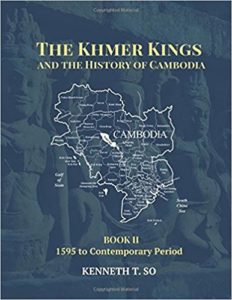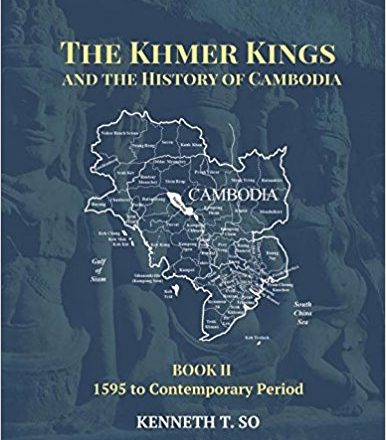The Khmer Kings and the History of Cambodia: Book II
Summary:
- Author (s):
- Kenneth T. So (Author),
Jacqueline So (Cover Design) - Release:
- 2017
- Category:
- Books
- Order a Copy:
- From Amazon →

The Khmer Kings and the History of Cambodia: Book II
– 1595 to the Contemporary Period
In the centuries that followed, the threat from Siamese hegemony continued growing until King Norodom petitioned France for protection.The French Protectorate Period began in 1863, but transformed into the French Colonial Period as controls increased. Finally, King Sihanouk succeeded in gaining independence for Cambodia on 9 November 1953.
Book II details how ancient relationships between Cambodia, Thailand, and Vietnam evolved in the modern era. The book examines how Cambodia lost Kampuchea Krom/Cochinchina, how the Khmer people were forced to build the Vinh Te canal, and how Thailand and Vietnam used Cambodia as the battlefield to prop up Khmer monarchs that they controlled. Finally, we examine the 20th century birth of the Khmer communist party, the central issues of Pol Pot’s elimination of his communist comrades in the context of the war that ensued, and the complex regime changes between the Khmer Republic, Democratic Kampuchea (i.e. the Khmer Rouge), the People’s Republic of Kampuchea under Vietnamese occupation, and the current Kingdom of Cambodia.
About this Edition:
Book II is supplemented with nearly one hundred color tables, charts, photos and diagrams, references, bibliography and full index.
Read also:
The Khmer Kings and the History of Cambodia: Book I
– 1st Century to 1595: Funan, Chenla, Angkor and Longvek Periods
2017 • Book details • Buy on Amazon
Book Details:
Paperback
Publisher: DatASIA, Inc.
Date of Publishing: November 1, 2017
Language: English
Pages: 440
Cambodian-American Rocket Scientist Publishes Cambodian History Opus
Kenneth T. So, an award-winning Cambodian-American scientist who worked for NASA and aerospace companies for 35 years, has completed a 25-year project more challenging than rocket science: creating a monumental, 800 page history of Cambodia, from its origins to the present day.
Despite its spectacular monuments at Angkor, which attest of a powerful empire that dominated Southeast Asia a millennium ago, whole chapters of Cambodia’s history remain a mystery.
This is what led Kenneth T. So—a Cambodian-American senior rocket scientist who worked for NASA and aerospace companies for 35 years—to try filling the gaps.
For a quarter of a century, he applied himself to his historical research during his every free moment, using the same dedication that had earned him the NASA Langley Research Center’s Chairman Certificate of Appreciation in the late 1980s. Since his retirement, So has worked full time to complete his monumental opus, commenting “Compiling a detailed history is not rocket science…it is much harder!” His books became available on Amazon worldwide Nov. 1.
Entitled “Khmer Kings and the History of Cambodia,” his 2-volume work covers more than 2,000 years of the country’s history, including the Angkorean era that spanned six centuries, and the Cold War era of the 1960s and 1970s during which Cambodia fell under the control of a genocidal government, the Khmer Rouge.
“Khmer Kings and the History of Cambodia-Book I” focuses on the shaping of the nation, covering the periods from the first century on, which became known as Funan and Chenla, up to the 1590s when Siam—as Thailand was then called—sacked the country’s capital of Longvek, an episode that profoundly marked Cambodia in every way. “Khmer Kings and the History of Cambodia-Book II” covers the country’s history and evolution from 1595 up to the present day.
These Cambodian history books are especially significant because they were written by a Cambodian who spent his entire life with the culture, and fluent in the Khmer language. Over the past 150 years, most books on the subject have been written by Western scholars, who interpreted the kingdom’s history from their own perspectives.
“Khmer Kings and the History of Cambodia” sets a new, comprehensive benchmark of understanding. Weighing close to 11 pounds (5 kilos), the two-volume set totals 804 pages, with more than 150 color photos and diagrams—including what may be the most detailed genealogical chart of Cambodia’s royal families ever published—as well as a reference section, a bibliography, appendices and a full index.

